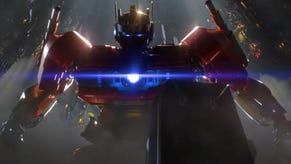"Road to the PS4″: Watch Mark Cerny's GameLab talk here
PS4's system architect and Knack creator Mark Cerny gave a talk about his work on Sony's new console at the GameLab expo in Barcelona last week. "Road to the PS4" discusses the console's creation, and more. You can watch it again here.
Kicking off the GameLab expo, Cerny took to the stage and opened with an insight into his 31-year career in game development. He has worked on some 30 titles that have either been first-party or 'close-to' first party, and stated that while they weren't high-tech, they looked advanced, which is testament to the power of good development.
Cerny recalled his time at Sega, and how the company's president at the time wanted the group to focus on quantity of titles for its new Master System console, rather than quality. The team only managed its first million-seller in Sonic the hedgehog but pouring all of its resources into one title.
While working at Crystal Dynamics, Cerny caught wind of the early development of PlayStation, and managed to sign an early contract to secure what he believes was Sony's first Western dev kit. It was approved by Shuhei Yoshida himself.
Over time he helped create the original Crash Bandicoot and co-founded Insomniac Games. He quickly learned the PlayStation's architecture and saw the value of pouring vast resources into a single title.
By the time PS2 development was under-way, Shuhei Yoshida found that early developers were finding the console hard to code for, so he invited Cerny in to work alongside studios to help them get the most out of the hardware.
Creating an engine that could get the most out of the PS2 hardware was a difficult task, and Cerny suggested this was a wake-up call for Sony. He found that team sizes were getting bigger in order to hit the quality bar possible on the console.
Due to growing team sizes and costs going into PS3 development, Yoshida thought that sharing talent, resources and tech across multiple teams would be a good way to create early tech, and help the first PS3 teams make their debut projects on the format.
It was called the 'ICE' team, and it involved members of Naughty Dog and other internal Sony studios. Members of the ICE team - including Cerny - were invited to be instrumental in creation of the PS3 hardware in Tokyo.
Cerny went there and saw the console's early creation, which involved no more than a dozen engineers. By this time the CELL processor was done and Cerny was asked to see what could be achieved on the processor. While he was thinking about the power of the PS3's output, Cerny didn't realise how this would impact the console's retail cost.
The believe was that the CELL processors grunt would show third-parties like EA and Rockstar how development was done, and Cerny admitted that this bullish approach was wrong, but that the company simply didn't know any better.
It was now 2005, and Cerny said the format was '99% hardware, 1% software'. He added that developers were having a difficult time building games on the format, and even low-level graphic engines were taking much longer than they should.
The company then turned its attitude around and realise that first-party developers, titles and systems alone would not be enough, and it started looking at third-party studios and how they could help bolster Sony's suite of talent and tech.
In 2007 Sony began a post-mortem analysis of PS3 to see what happened, what went wrong and to apply this to the concept of PS4. The ICE team and other Sony developers were all incited to discuss the format and what was needed from studios.
PS4's creation and beyond
Cerny started researching x86 architecture to see how it might open up the PS4 platform and streamline the development process. He considered working on the idea of using this tech more deeply, and looked at how Intel and AMD approached the issue of tech.
He decided that whoever ended up designing PS4 would need a base understanding of what game producers need from hardware. Yoshida and other Sony execs deemed Cerny suitable for the role of PS4's architect, and his research began proper in Tokyo.
He was then given 'freedom to succeed' - as he put it - without staff or red tape. His role was to simply explore what could be possible on PS4 and development began in 2008. He established some new principles that would apply to Sony moving forward, such as a collaborative and international approach to developers.
First party input aside, the company issued questionnaires to third-parties to ask them what they wanted from the new console in terms of technical performance and more. The number one feedback was that developers wanted unified memory system, and that a powerful GPU was desirable.
Although Ken Kutaragi had left the console development side of Sony's business by then, Cerny kept in mind he would have wanted PS4 to be. He also took inspiration from Nolan Bushnell's arcade game development guidelines of 'easy to pick up, but difficult to master'.
Cerny didn't want the PS4 hardware to be a puzzle.As a yardstick he aimed to use a small eDRAM within PS4 which would allow processing of 1088GB per second. In real terms it can process 176GB per second.
I'm no tech-whizz, so I'll just paste Cerny's slide on the matter. It's easier trust me:
Cerny continued that while the PS4's technical grunt was important, it would mean nothing without content and so he urged Sony to establish a sustained dialogue with third-party studios like Ubisoft and Rockstar. He has since toured studios with long presentation slides to show developers that the console is a viable prospect in next-gen.
He explained that in one meeting - in which he wasn't present - a developer said 'if PS4 doesn't have 8GB of RAM then it's dead'. The company took that seriously and alas, it has 8GB of RAM inside.
Cerny closed his chat by saying that Shuhei Yoshida has a master plan for where PS4 will go moving forward, and that while the next five years will be hard to predict, the company is keep its dialogue with developers open to ensure it takes the right steps.
That's all folks. What did you think of Cerny's chat? Let us know below.





.jpg?width=291&height=164&fit=crop&quality=80&format=jpg&auto=webp)





